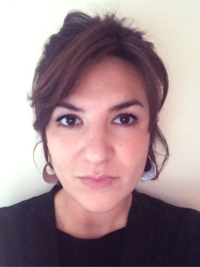Elena Dorato

XXIX Cycle - (A.A. 2013-2014)
IDAUP
Home Institution: University of Ferrara
Without Scholarship
Curriculum: Urban Planning (ICAR21)
Research Topic: Urbanism enhancing health/physical activity
Tutor DA-UNIFE: Romeo Farinella
Tutor Polis University: Artan Fuga
External Expert: Antonio Borgogni
Nationality: Italian
Email: drtlne@unife.it
Profile
Biography
Born in Turin, Italy in 1987, Elena Dorato is an Architect, graduated cum laude in Urbanism from the Architecture Department of the University of Ferrara. She developed her Ph.D. research titling “The Active City. Urban planning and design enhancing health and physical activity” between 2014 and 2016 (IDAUP, approved cum laude), and she is currently Research Fellow in Urban Design at the CITER research Lab of the Architecture Department - University of Ferrara, where she also teaches the course of “Urban, Environmental and Territorial Restoration and Regeneration”, tutoring many graduate theses.
She is member of several international research groups and coordinates a variety of works and projects, working for public and private authorities and focusing on the relations between Urbanism and the health disciplines. Also, both as a professional and a researcher, she has been dealing with the issues of territorial reconfiguration, especially involving riverscapes and water landscapes. She's been working in several countries, collaborating with different Universities and public bodies (i.e. Senegal, Mexico, Cuba, Colombia, China, Spain, Denmark, Finland), and publishes scientific articles on national and international journals and volumes.
Research skills
Urban Design | Urban Planning | Urban Studies | Active Mobility | Participatory Planning
Scientific activities
ORCID ID:
0000-0002-7981-6760
IRIS UNIFE ID:
rp12398
Doctoral research
The Active City. Urban planning and Design Enhancing Health and Physical Activity
The thesis asserted by this work is that Urbanism has the great power to take care of the urban population's health, life quality and wellbeing, and that the model of the so-called Active City could represent a potential, positive vector to reach such goal. By investigating the relationships between urbanism, public health, and the urban environment – with a specific focus on physical activity as one of the principal contributors to health outcomes – this thesis wants to tackle from an urban design and planning perspective the complex relationships and cause-effect processes linking the characteristics of the urban built environment to people’s health, lifestyles and wellbeing; to urban health and the levels of health-enhancing physical activity. For long such connections have been faced predominantly from an epidemiological, social, sport and physical activity sciences point of view, at times mentioning and yet not in-depth investigating and effectively addressing the characteristics and forms of the urban built environment in which most people around the world live, understanding them as fundamental determinants of health and physical activity levels. Since the industrial revolution of mid-XIX century, the sanitation problems of the contemporary city have greatly changed, and so have the social structures and people’s needs. Health and the practice of physical activity are no longer an exclusive matter of epidemiologists or sport scientists, but yet an overriding goal to be achieved also thanks to comprehensive and integrated interventions on the physical environment in which communities live and develop, addressing through urban policies and programs and also from a design perspective the problem of urban living in terms of sustainability, safety, accessibility and attractiveness, and possibilities for all citizens to acquire healthier and more active habits and lifestyles. Without presuming of being exhaustive, nor desiring to define a generic formula to be globally applicable, the overall objective of this research is to shift the theoretical point of view, as well as possible operational approaches, from a medical and social issue to an urban one, exploring the broad and fast-developing field of the Active City in a comprehensive way. The main goal is to investigate how 'the city’ (i.e. its public and collective spaces as privileged places for urban sociality and activities, and the transformations they experience by means of planning and design processes) can help all citizens to live healthier lives through facilitating and enhancing the practice of physical activity on a regular basis, mainly considering the two kinds one can practice within the urban realm: leisure-time and transportation physical activity. The thesis wants to systematize the already existing theoretical and operational knowledge on planning and building healthier and more active urban neighborhoods, in order to build a reliable profile of the multifaceted relationships between urban environment and individuals, their health and levels of practiced physical activity, defining a clear and well-established framework on which to ground future urban projects, researches and actions. By combining the disciplines and approaches of urban planning and urban health, actuating multilevel and integrated strategies, policies and projects on the urban environment, great achievements can be reached on individual choices of practicing health-enhancing physical activity. In this perspective, a further analysis and definition of the Active City (analyzing the relationships in terms of urban current issues and debates; historical development; case-studies and new approaches and tools; and by interpreting these facts and connections, envisioning new operational perspectives in the urbanism field) could represent an appropriate, effective and broadly exploitable and applicable urban paradigm to be then implemented at different scales. Common issues, potentialities and threats need to be identified and understood in order to create critical mass, and then define an extensive and adaptable set of guidelines which will need to be applied case-by-case, according to local characteristics and site-specific goals. The research is qualitative, interpretative and deductive; diachronic in showing how the relationships among the main investigated fields and concepts have evolved; theoretical, and partially based on a multiple and illustrative case-study approach (i.e. cities of Barcelona, Berlin, and Copenhagen). The investigation tools that have mainly been used are scientific literature and gray literature review, observations, and documentary research.
Keywords
Urbanism | Active City | Public Space | Public Health | Physical Activity

